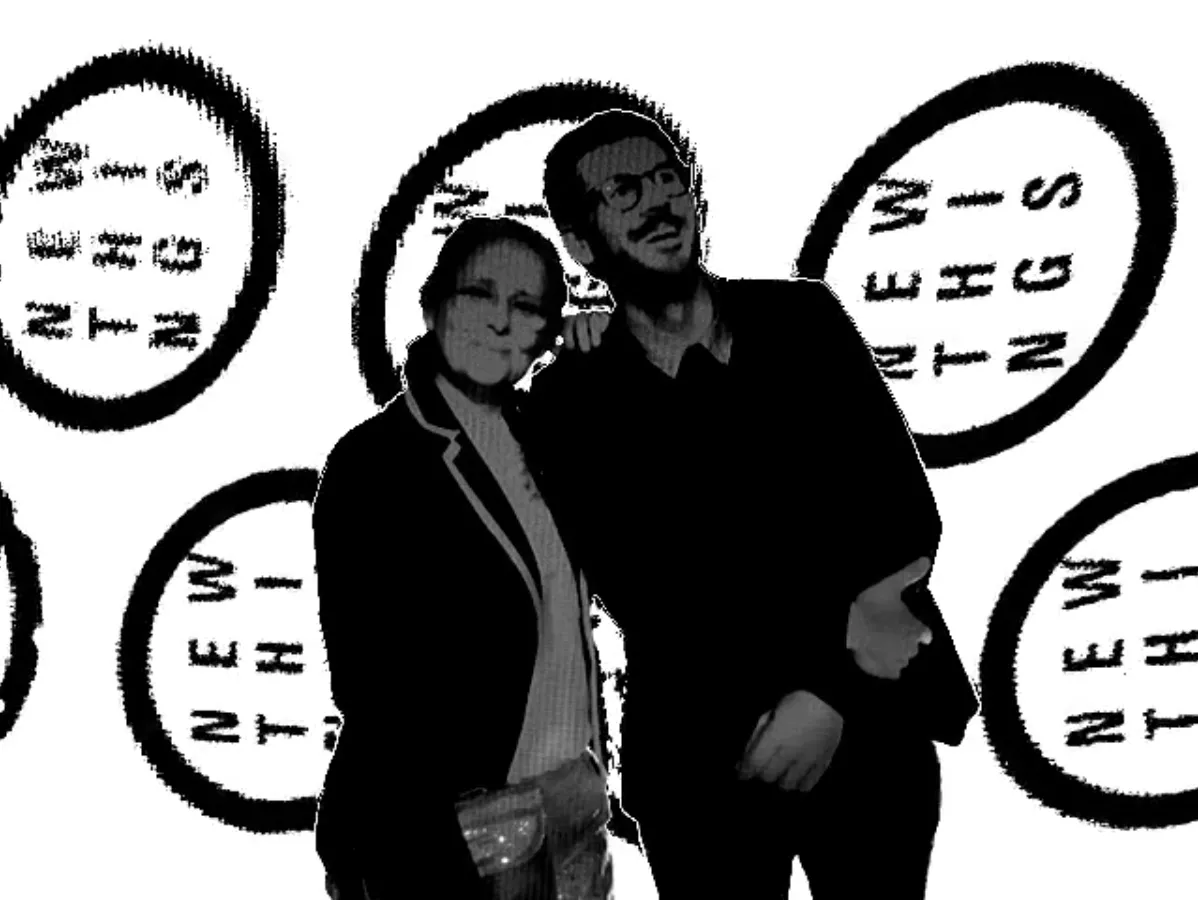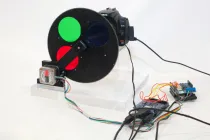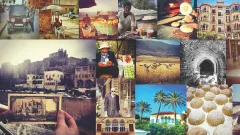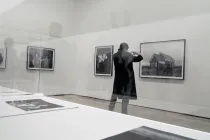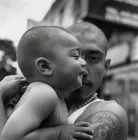
Ulli Barta: I am a creative strategist and producer, curator, connector, organizer. Previously, I co-founded and was CEO of Lomography NA (1997–2010) and CEO of The Impossible Project NA (2010–12). I have a medical degree in midwifery. And I am still operating in a similar arena in many ways: facilitating, assisting, and guiding “new life,” new ideas, and projects into fruition. From light to matter… I was born in Austria and have lived in New York City since the mid-1990s.
Fabrice Nadjari: I am a creative entrepreneur, content strategist, and visual storyteller, born and raised in Paris. I moved to New York four years ago, as the author of a documentary photo and film project on Afghanistan that I co-directed and that ended up being shown at the United Nations and nominated for an Emmy. My background is in entrepreneurship as I started to create companies right out of school, at the beginning in parallel with a full-on “corporate” job.
We created Studio 55 in 2013 as a platform of exchange and a way to build bridges between the world of art and entrepreneurship. As creative strategists and producers, we conceive, analyze, initiate, consult, coach, curate, and connect. We work with art institutions, creative entrepreneurs, artists, and international cultural projects.
Can you tell us about your ICP public programming mission: what you are building and how it came to be?
As clichéd as this might sound, there is a real and urgent need for transdisciplinary conversations in the world of visual arts today. The myth of the genius artist cutting off his ear alone in his studio is long over—today’s artist is evolving toward the figure of the creative entrepreneur—a visionary, connected, well surrounded, with the ability to articulate and unfold a vision through different analog and digital platforms, aware and proactive in the light of all the possibilities the globalized art market has to offer.
This especially applies in the field of photography and image making. The industry’s traditional business models have been shaken up and redefined in the last five years, in parallel to the dramatic increase of tools and platforms multiplying the available ways and channels of representation and storytelling. These changes obviously raise concerns and questions for a community that now has to adapt to an entirely new set of rules, tools, and requirements.
We ourselves have many questions in this context but did not find this conversation being offered in any continuous academic or institutional context. There are obviously great initiatives, for example, Photography Expanded by the Magnum Foundation, but these events happen occasionally, not in an ongoing and regular format. We were eager to hear and trigger these conversations; hence we decided to articulate a whole series of events around them. And what better venue and platform than the International Center of Photography to host these exchanges? The institution that was originally founded as the Center for Concerned Photography by Cornell Capa has built its reputation on some of the best photography content of the last 60 years. However, the connection with the 21st century and its new means and technology was not the biggest priority in recent years.
This year, ICP is also at a very crucial and interesting moment of its existence, with the museum being dark, its move to the new location on the Bowery, bringing visibility and access to new audiences that will allow the institution to redefine itself and find original ways to connect storytellers and their work with these existing and new topics and communities.
In September 2014, we worked with ICP on a collaborative event for Sebastião Salgado and were able to start the conversation first with Fred Ritchin and soon after with Mark Lubell. We finally presented our ideas and program suggestions in early spring of this year and found open minds and ears. In collaboration with a great team at ICP, we have been able to quickly work out and implement the first semester’s program in a very short time.
What stories and themes have been discussed during this spring 2015 semester?
ICP’s public programs are built on three organizational pillars, and each semester has two to three themes of overarching content. The spring 2015 topics were social media and new communities, new platforms for storytelling and engagement, and new business models in photography:
- #ICPmeetup | Photography and Entrepreneurship
- #ICPtalks | Lectures, Conversations and Panels
- #ICPworkshop | HowTo Introductions
#ICPmeetup: In these monthly meet-ups, we ask founders and CEOs of companies that redefine and reinvent the ever evolving field of storytelling to share their vision and exchange with our audience. The concept of “meet-up” is well implemented and successful in the tech and start-up world, but the response of the photography community to these particular events has been tremendous! Conceived as an exchange platform between storytellers, image makers, and technologists, the meet-up is a venue for a much-needed dialogue between people who define what the field of photography will look like tomorrow and their audience, content creators and possibly early adopters of their burgeoning technologies and interfaces. This semester we had the chance to welcome and hear from the founders of exciting ventures such as Blink, Capture, 500px, Medium, Atavist, Hatch, Art:I:Curate, Artlist, just to name a few.
#ICPtalks: The second pillar is composed of lectures and panels in which image makers speak about their work, creative process, most recent projects, and overarching vision. This is the most traditional format of our program. #ICPtalks is a mixed offer comprised of, on the one hand, very traditional master conversations and, on the other hand, our little twist to this format is to allow the audience to see how these storytellers challenge the traditional approach to photography with new perspectives and the use of new platforms and mediums. This semester we presented the recipient of the 2015 ICP Infinity Award Graciela Iturbide, Michael Premo and his approach to multimedia storytelling, Youmna ChamCham and her inspiring LiveLoveBeirut Project, and Tomas van Houtryve and his use of drones.
#ICPworkshop: The third component of public programming takes the form of straightforward HOW TO? Workshops—two to three hours each—about current key learning points and tools of the trade that might seem logical yet often out of reach to subjects, such as social media platforms, drone photography, etc. In the spring semester, we hosted workshops: “HOW TO – instagram” and “HOW TO – fly drones".
What are the main takeaways from the recent talks, meet-ups, and workshops?
We really love to bring a healthy mix of conceptual reflections and pragmatic recipes to the audience. For instance, a subject like How Is Instagram Changing the World?, one of the first #ICPtalks we presented, inspired the Dean of Education at ICP to write an excellent article on the crucial questions Is Instagram Photography? Does It Matter? while the HOW TO Instagram | #ICPWorkshop, which happened a few weeks later and focused on the applied use of that same platform, provided very precise pointers to our audience on how to expand their following, fine-tune captions, and compose images, and we even introduced a new format we call the “Instafeed Review.”
We very much appreciate the back and forth between theory and practice. We think it is essential for aspiring and professional photographers to find both types of conversation at ICP. From that same perspective, we were also able to question the fundamentals of the use of drones through a panel featuring a diverse roster of engaged artists working on this topic, and a few weeks later we offered a workshop about drones and aerial photography in which photographers could learn how to fly these very devices, and about the historical context and legal ramifications of the use of the medium.
ICP has recorded most of this year's events, so if you were not able to join in person, you can watch them on the ICP Public Programs Spring/Summer 2015 YouTube playlist.
What do you see are the greatest challenges for photographers today? What about their greatest opportunities?
We like to think that the greatest challenges the profession faces nowadays are also where the greatest opportunities for image-makers arise. First and foremost, photographers face the expansion of industry requirements: where it used to be enough to create and produce photographs, today’s photographer now must also know how to be an editor, publisher, and videographer, and to collaborate on variety of levels. We see the necessity of effectively connecting, engaging, and leveraging the photographer’s work with his audience, and understand at the same time the importance of translating his vision to not one but a whole variety of different audiences. We also recognize the huge challenge in gaining fluency in a multiplicity of platforms. First and foremost, photographers face the expansion of industry requirements. Where it used to be enough to create and produce photographs, today’s photographer must also know how to be an editor, publisher, and videographer, and intensely collaborate on variety of levels.
We are no longer living in a time of “either/or” for storytellers but in an extremely interesting era where everything is possible, and not only for the very happy few who manage to get the attention of a top-tier gallery!
Would you tell us about the photographers’ use and perception of social media?
The use of social media should be a direct extension of photographers’ work and creative vision. It’s always most important to inform oneself, and then choose accordingly. We are not evangelists of the obligatory use of social media for any photographer, but in today’s day and age it is kind of hard to understand that an artist who wants to connect and find outlets and audience for his or her work would not want to use these powerful and very affordable means for doing exactly that.
Social media platforms are also an exciting playground for new ways to use the medium, and push the boundaries of what photography is supposed to be. Take, for example, Alec Soth’s Snapchat project or Richard Prince’s selling of other people’s Instagram posts for exorbitant amounts of money.
What is the role of a photography museum in 2015?
The photography museum of 2015 is a place where the photo lover can find everything from Capa to her favorite Instagram feed pulled out of her phone onto a live screen, from a gorgeous silver gelatin print to curated paper pastings on the museum walls and its surrounding community, raising awareness about current political issues. It’s a place where the important issues of visual storytelling are being debated, in an interactive, connected, and contemporary way. Shows are not limited to the museum walls and screens but engage the surrounding community’s buildings and streets via projections, and the museum’s archive is opened to hackers to innovate the ways archival holdings can and should be used. The 21st-century photography museum is a place of interactions, experiments, conversations, and challenges of local and international dimension, you know, something like the International Center of Photography.
What can we expect for the Fall 2015 Public Programs at ICP?
The overarching topics of the fall semester will be hacking, literally in the form of a Hackathon, and figuratively from the perspectives of disruptive technology and “hacked” tools along the lines of “New Forms of Storytelling Induced by Technological Innovations: From Virtual Reality to Computational Photography.” We will explore “Shortform Moving Image Storytelling: From Gifs, to Vine, Snapchat, and High Art Videos.” We will visit the important topic of data visualization. And in the light of the civil rights movement #BlackLivesMatter, we are also taking a close look at the influence of citizen journalism, alongside local versus national / international reporting in war and crisis photography.
We are working on the confirmation of the speakers now and we can guarantee you the roster of interesting topics, voices, and people to meet in the fall 2015 semester is going to be even better than the first semester!
Thanks to ICP for giving us the opportunity to pull these amazing speakers into the ongoing conversation about photography in 2015.


